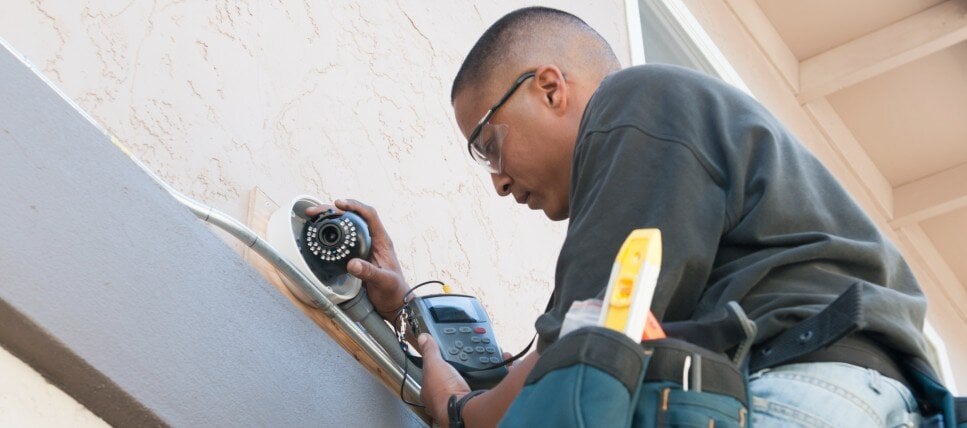Keeping a consistent identity from one facility to the next is a major priority for national brands. Whether a chain of convenience stores, retailers, or corporate offices, it’s critical to create the same customer and employee experience in each location.
Maintaining brand standards and a corporate identity go beyond store layouts and logos, however. Internal processes and behind-the-scenes technologies need to be standardized, too. That can be difficult when facilities are spread across the country with different vendors, permitting processes, equipment availability, and more.
Whether renovating existing facilities or building new, a national technology rollout that replicates results at each location requires a consistent team with a consistent process. Here’s a step-by-step approach to how ASD achieves a successful national technology rollout.
CASE STUDY: 2 Weeks. 150 Sites. 1 Happy Customer.
Step 1: Planning & Design
Long before technicians show up at various locations, a planning team must work closely with stakeholders to create an achievable schedule, including internal and external meeting cadences.
Some elements of the planning process include:
- Taking the time to understand needs and set clear expectations
- Creating a “responsibility matrix” that defines who owns each piece of the deployment
- Building a Gantt chart or project tracker that outlines expectations
- A full list of locations that are part of the rollout so resources can be allocated
- Scheduling of weekly 30-minute check-ins between the client and project manager for the duration of the project
- Detailed scopes of work with pictures, installation tips, and clearly defined responsibilities for deployment
- Reporting protocols, training, and a plan to address escalations
RELATED: Technology Design Pricing Guide
Step 2: Kickoff & Communication
Communication is the key to any project’s success. Once a plan is in place, a kickoff call must be conducted between the client, project manager, account manager, and other involved parties. Plans will be adjusted as needed.
Some large-scale rollouts begin with a pilot program to demonstrate success on a smaller scale before launching nationally. In such cases, a team completes installations at a handful of locations — in relative proximity — and develops a runbook for the full rollout using their learnings.
From there, ASD builds routes for the remaining locations using our AASDITM (Authorized ASD Installers) network. Partnering with a provider who leverages a network of vetted professionals results in lower costs per location, and helps ensure consistent results and success rates.
3. Staging & Logistics
With multiple locations, there can be thousands of pieces of equipment and components. Keeping them all straight is critical. In many cases, the client ships their equipment to ASD to be properly secured and stored before deployment.
An integrator should be able to provide image management, configuration, testing, kitting, racking/stacking, and more. Inventory control software helps ASD manage inventories, equipping our teams to handle lifecycle upgrades and replacement/warranty requests as needed. We also offer a full e-cycling platform to support sustainability efforts.
Inventory management and equipment tracking can include:
- Custom reporting and serial number tracking
- Use of a barcode system — each piece of hardware receives a unique identification to streamline asset management
- Reporting at designated frequencies
- Low inventory and reorder alerts
- And more
Staging before going on-site enables faster deployment and minimizes site disruptions like misplaced or lost components. An integrator must track equipment shipping with adequate insurance coverage, and they can even use a client’s shipping accounts to help reduce costs.
CASE STUDY: FedEx Freight National Technology Rollout
4. Field Selection of Installers
There’s no substitute for having boots on the ground. ASD deploys trusted technicians across North America through their AASDI network. The AASDI (Authorized ASD® Installers, pronounced “as-dee”) network is a database of 3,500+ certified, vetted, and rated technicians located across the US. Our project managers will select the best local technician for the job. They are insured and treated as an extension of the ASD team.
There are numerous benefits to leveraging local technology installers for a deployment:
- They’re licensed and certified to work in a particular state or county
- They have rapid response times
- The client can have the same onsite support person for future needs
- Clients feel good knowing they’re supporting their local workforce and economy
- Local technicians know local inspectors and permitting requirements, helping to streamline projects
We provide our AASDI partners with any necessary training, tools, and manuals for niche deployments, and conduct extensive project kick-off calls to ensure they’re thoroughly prepared.
5. On-Site Coordination
Each project location is assigned a dedicated project manager to ensure everything goes smoothly. For large projects with repeatability across multiple locations, it often makes sense to have one project manager to maintain consistency.
Once ASD’s team is on-site, project managers and technicians use our proprietary AASDI™ Mobile App to remain in constant communication. Dispatched technicians can check in, check out, and upload photos in real time to streamline reporting and communication.
6. High-Quality Deliverables
The communication and transparency enabled through the mobile app is an added layer of quality control. At ASD, our teams work closely with clients to understand expectations and determine their needs. Project requirements, data, and descriptions are then entered into the mobile app for technicians to reference and confirm the work to be performed.
Our mobile app allows technicians and project managers to focus more on quality control, rather than getting bogged down by manual reporting through emails, paperwork, and other administrative tasks. The app also empowers our AASDI partners to create daily logs and document deliverables, simplifying the process and allowing them to concentrate on the intricacies of each project.
To ensure the highest standards of quality, our technicians are required to submit all necessary project photos, sign-offs, and additional documentation before leaving the project site, maintaining a consistent verification process.

7. Support & Remote Management
It’s important to consider a technology integrator’s commitment to client relationships beyond the initial installation. ASD takes pride in being full project lifecycle partners, ensuring support and remote management throughout.
Our advanced monitoring tools allow us to detect and address issues, often before our clients are aware, to provide seamless and proactive service experiences. This 24/7 support includes everything from critical system oversight to routine break-fix tasks, helping clients maintain their investment across their national operations. And because our technicians are local, they can respond quickly without significant travel costs.
Post-project processes include a mandatory 'lessons learned' call following every rollout, aimed at continuous improvement. This process begins with an internal discussion among all ASD team members, followed by a candid, open conversation with the client to discuss both successes and areas for improvement.
This commitment is exemplified through our broad array of support and services, including cabling, WiFi, fire inspections, access control, AV technologies, and more, ensuring comprehensive solutions for every aspect of your project. Check out our pricing guide for additional details.
A national technology rollout is challenging when having to work with various vendors in different communities, each with their own processes and definitions of quality. Brands can standardize their technology and its implementation by working with a national provider like ASD. Contact us to discuss your national technology rollout and explore how we can help.



Leave a Comment